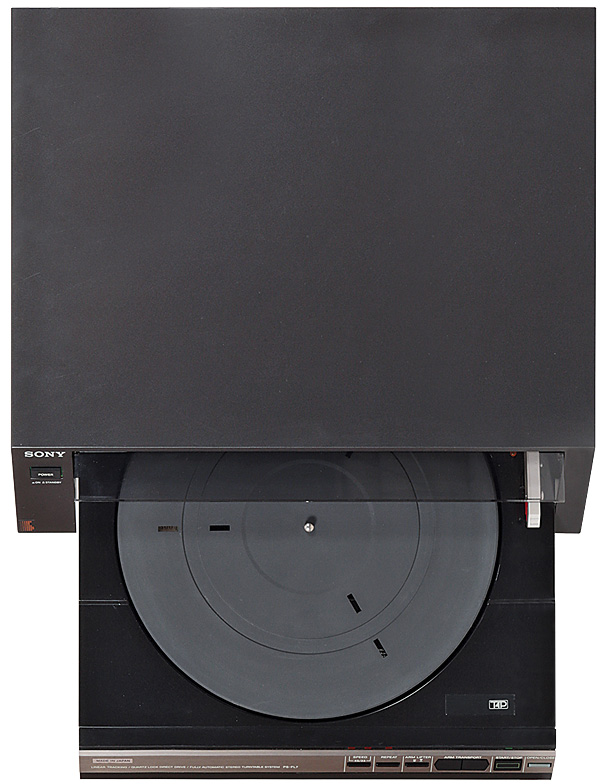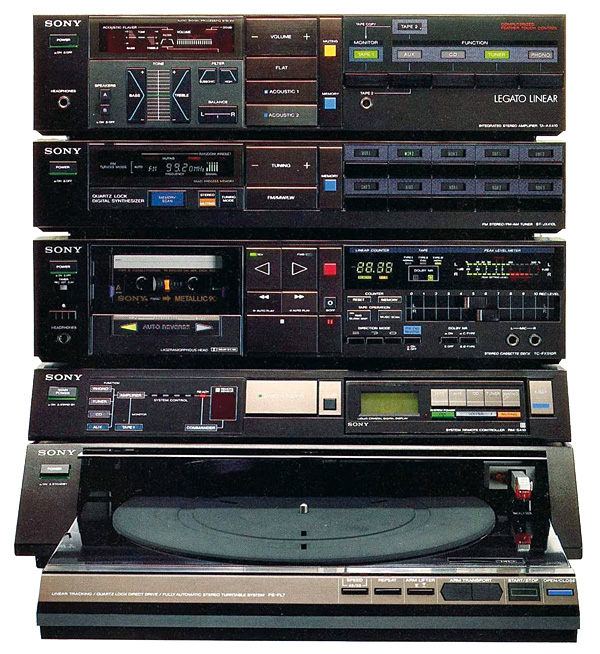Sony PS-FL7 turntable Page 2
There is no grounding cable for the arm but despite this, and the proximity of the arm wiring to many complex processes going on inside the machine, I could not hear an excess of hum or any other unusual noises through the amplifier as the records played. The main motor was silent and the arm servo unobtrusive – an improvement over that of the Technics SL-10 turntable with its distinctive 'bump-thump' noises which sometimes become noticeable during quiet musical passages.
![]() Tim Listens
Tim Listens
Given its unusual layout and construction, it isn't surprising to find that when it comes to sound quality the PS-FL7 cures some of the ills of a conventional turntable but in turn introduces a few of its own. For example, the very short arm seems capable of the sort of lively, largely uncoloured sound that one normally associates with CD yet it's unusually sensitive to warped records. A traditional arm can usually handle warps without much audible effect, but in the Sony one can see the changes in the vertical tracking angle (VTA) of the cartridge as it rides over the humps. While I'm sure that no HFN reader allows their records to become warped (!) there inevitably comes a time when a not entirely flat disc has to be played, and in extreme cases a loss of tracking security was noted with this deck, the effect being increased distortion in the area of the warp.

With the Sony XL-250G cartridge supplied with our review sample I found the sound to be a little hard and bright for my taste, although the overall effect of this will depend to a great extent on the partnering system used. However, swapping the Sony cartridge for a moving-magnet Audio-Technica AT85EP produced a tonal balance with which I was much happier.
When used with reasonably flat records, this combination showed the PS-FL7 to be a decent performer which just seemed happy to play whatever was loaded into it in a matter of fact, ungilded manner. 'Driver's Seat' from Sniff 'N' The Tears 1978 album Fickle Heart [Chiswick CWK 3002] sounded pleasingly upbeat when heard on the PS-FL7, with a most satisfying bite to the guitars that open the track. One could describe the sound as being like a TV picture with the contrast setting turned right up, strikingly vivid at the cost perhaps of some of the fine detail. For rock and some electronic music this is, of course, exactly what you want, although some may prefer a presentation that is a bit more relaxing.
Right On Track
Some classical pieces benefit from equipment having a bit of vim however, an example being Deutsche Grammophon's recording of Beethoven's Piano Concerto No 1, with Maurizio Pollini and the Vienna Philharmonic [DG 2532 103]. While there wasn't quite the space around the performers that top-flight linear-tracking turntables such as the Technics SL-10 and the B&O Beogram 4000 [HFN Jun '14] can provide, the performance from Sony's PS-FL7 was still an involving one.
One thing that did surprise me though was the occasional audible waver around a sustained piano note, something that one hears commonly enough with belt-driven turntables but is rarely heard with direct-drive designs. Whether the extreme lightness of the PS-FL7's platter contributes to this I don't know, but it was an unexpected observation given that the turntable's basic speed accuracy was spot-on. In any case, it was a pleasure to hear the complete Allegro con brio on side 1 with no degradation in tracking performance towards the centre of the disc (a virtue of the linear-tracking system).

In the final analysis, the PS-FL7 isn't really a match for the Technics SL-10 (or the later SL-7 for that matter), but I get the impression that it was never really meant to be. Seen as the simplest and safest way to listen through a side of an LP the design works with slick efficiency, although as ever with turntables of this type there is little for the hobbyist to do once it is set up, other than play records.
Buying Secondhand
The PS-FL7 was one of the less common models in the Sony drawer-loading series but the following comments apply to many of the other versions too, some of which are still easy to find secondhand.
The Sony XL-250G cartridge has a replaceable stylus (type ND-250G) and even though Sony no longer makes it, pattern copies are available. The quality of these is quite variable though and you may have to try a couple before you find one that approaches the performance of the original. The Audio-Technica AT85EP is a good replacement for the whole cartridge and even comes with a stylus optimised for linear-tracking designs.

The remainder of the turntable design is quite reliable although the belt that drives the arm carriage can stretch with age, meaning that the arm stub either moves sluggishly or not at all. The switches behind the control keys can also corrode inside, stopping some (or all) of the functions from being accessed by the user. As with the belt, these parts are reached from underneath. In practice, most repair operations involve removing the bottom of the turntable's cabinet rather than the top.
Modern switches to a suitable pattern are still available so other than the amount of dismantling required this is not an especially difficult repair. As with all Sony turntables made from SBMC, be very careful when tightening any screws which seat into this material. It's easy to pull the threads out and make a component or assembly difficult to secure back in place.
Hi-Fi News Verdict
It may be one of Sony's less well remembered endeavours, but this drawer-loading, linear-tracking turntable deserves another look. An attractive combination of advanced technology and high-quality engineering, it's certainly a different take on what a turntable can be. In fact, our review sample was mistaken for a CD player as it filled our 'vintage room' with music at the 2019 Hi-Fi Show Live!. Enough said?























































